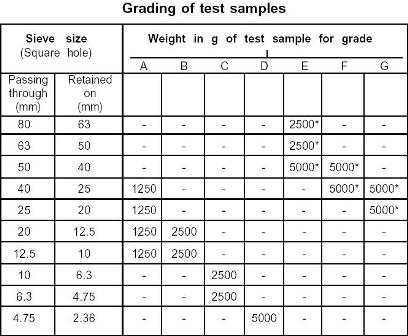Soundness test on Aggregates (IS 2386 Part 5 )
Soundness of aggregates is the resistance possessed by the aggregates against the weathering agencies.To quicken this weathering action due to alternate wetting and drying and freezing thawing saturated solution of sodium sulphate or magnesium sulphate are used.
Apparatus
Sample, Weighing balance up to capacity 500 g (Least count 0.1 g), Weighing balance up to capacity 5000 g (Least count 1 g), Oven, Sieves, 80 mm, 63 mm, 40 mm, 31.5 mm, 25 mm, 20 mm, 16 mm, 12.5 mm, 10 mm, 8.0
mm, 4.75 mm, 4.0 mm, 2.36 mm, 1.18 mm, 600 micron, 300 micron, 150
micron, Chemicals Sodium sulphate or magnesium sulphate, Wire mesh bucket, Container
Sample preparation for fine aggregates
- Make a sieve set with sieves as per the table starting from 10 mm to 300 micron.
- The amount of sample to be taken for sieving is such that, it will yield not less than 100 g of each of the following sizes.
- Weigh 100 g of sample from each of the separated fraction and place it in separate containers for the test.
Sieve set for fine aggregates
Sample preparation for coarse aggregates
- 1.Sieve the washed aggregates through 4.75 mm sieve and take the coarse aggregates retained over the sieve.2. Sieve the sample through 80,63,40,20,10,4.75 mm sieve and get the yield as per the table given below.3.Take the weight and put the sample in individual separate containers.
Sieve set and Yield limits for Coarse aggregates Procedure
- Take the individual samples of aggregates and put them in solution of sodium sulphate or magnesium sulphate for about 17 hours in such a way that solution is 15 mm above the aggregates.
- Now dry the aggregates and puth them in oven until they obtain constant weight.
- Now cool down the aggregates and repeat the first step.
- Number of such cycles are decided by the seller and vendor agreement.
- After completion of these cycles the aggregates are washed from sodium sulphate solution.And this can be tested by the reaction of the wash water with barium chloride.
- Now dry the aggregates and put in oven till they get a constant weight.
- After that cool down the aggregates and sieve the fine aggregates on same sieve on which they retained before the test.
- sieve the coarse aggregates on the sieves shown in table below.
Sieves used to determine loss
Note:-
Average weight loss should not exceed 12 percent when tested with 10 cycles of sodium sulphate and 18 percent when tested with magnesium sulphate.













